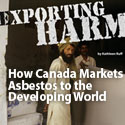Kathleen Ruff, RightOnCanada.ca
On December 1, 2009, a number of organisations, including the Canadian Cancer Society and the Canadian Teachers’ Federation, sent a letter to Minister of Health, Leona Aglukkaq, drawing her attention to the fact that exposure to asbestos is the single biggest cause of worker death across Canada. They noted that, as Minister of Health, Aglukkaq had a duty to protect public health and asked her to take action to address this “terrible, continuing and preventable public health tragedy in our country.”
The letter is available here as a pdf and is also provided below.
—–
Dear Minister Aglukkaq:
As Canada’s Minister of Health, you have a special duty to protect public health, a duty which overrides all other considerations.
Statistics Canada reports that 461 new cases of mesothelioma were recorded in 2006, an increase of 67 per cent over a decade and a half.
It is well recognized that for every case of mesothelioma from exposure to asbestos, there are at least two to three cases of lung cancer.(1) Consequently, taking a conservative approach and estimating only twice as many cases of lung cancer as cases of mesothelioma, one arrives at an estimated 1,383 new cases of asbestos-caused mesothelioma and lung cancer in Canada in 2006. That represents almost four new cases of asbestos-caused disease every day of the year. This figure does not include the many new cases of asbestosis each year.
Exposure to asbestos is the single biggest cause of worker death across Canada. From workers’ compensation statistics, it has been estimated that over 60% of Canadian workers who die from an occupational disease, die from having been exposed to asbestos.(2) Figures for Quebec this year show 84% of deaths from occupational disease were caused by asbestos.(3)
It is inconceivable to us that, in the face of this terrible, continuing and preventable epidemic and public health tragedy in our country, you, as Minister of Health, would continue to reject the call by the Canadian Medical Association, the Canadian Cancer Society, the Canadian Labour Congress, the World Health Organisation (WHO) and the World Federation of Public Health Associations to end the use and export of all forms of asbestos.
It is also shocking to us that federal government regulations permit workers under federal jurisdiction to be exposed to asbestos fibres at a level that is ten times higher (1 fibre/cc) than the level permitted in all other Western countries (0.1 f/cc) and one hundred times higher than the level permitted by a number of countries, such as Germany and the Netherlands (0.01 f/cc).
The Canadian government now is decades behind other Western governments in protecting its citizens from asbestos, thereby creating more future victims of asbestos. Sweden, for example, banned all use of asbestos in 1982. More than 40 other countries have now likewise banned the use of any form of asbestos.
We note that the government of Quebec has adopted a “zero tolerance” policy for exposure to asbestos, according to a spokesperson for Quebec’s Occupational Health & Safety Commission (CSST).(4)
At this moment, the federal government is carrying out a review of its 1 f/cc exposure standard for chrysotile asbestos contained in the Marine Occupational Health & Safety Regulations and in the Canada Labour Code.(5) The International Longshore and Warehouse Union and the Canadian Cancer Society have made submissions calling for the regulations to say that, as stated by the WHO and other health authorities, there is no safe exposure level to chrysotile asbestos.
We are very disturbed that, at this time, it seems that the Canadian government is rejecting these submissions and is going to refuse to change its dangerous exposure standard of 1 f/cc.
We are extremely disturbed by the fact that the Health Canada website and other government websites are giving Canadians misleading, inadequate and, at times, false information about asbestos risk. The Health Canada website states, for example, that asbestos only poses a risk if “significant quantities” of asbestos fibres are inhaled.(6) This is dangerously incorrect information. The scientific evidence is clear that exposure to even small amounts of asbestos can cause serious harm to health and can kill.
Another government website, to which Health Canada refers the public for information on chrysotile asbestos, states that: “Scientific evidence has demonstrated that it (chrysotile asbestos) can be used safely at low levels of exposure (approximately 1 f/ml)”.(7)
This is false information. The scientific consensus is that there is NO safe exposure level for chrysotile asbestos. Exposure levels of 1 f/ml will cause unnecessary disease and death for Canadians.
In a letter of May 23, 2008 to then Minister of Health Tony Clement, Dr. Leslie Stayner wrote as follows: “We have known about the hazards of asbestos exposure for nearly 70 years, and the evidence today that exposure to asbestos of all forms causes cancer and asbestosis is incontrovertible. The tragedy of disease from the use and production of asbestos in the West is now being repeated in parts of Asia, Africa and Latin America. Canada has a pivotal leadership role to play on this vitally important international issue. I hope that Canada takes this historic opportunity to demonstrate what a great and noble nation it truly is.”
In March this year, Dr Stayner was co-chair of the Working Group on carcinogenicity of asbestos for the International Agency for Research on Cancer, which is one of the most respected and authoritative agencies in the world on cancer. He was also a member of the Health Canada International Panel of Experts on Chrysotile Asbestos.
In light of the foregoing facts, we call on you, Madam Minister, as the member of cabinet with the foremost responsibility to protect public health:
* To respect the indisputable scientific evidence and support ending the mining, use and export of asbestos
* To support revision of federal government regulations to say that there is no safe exposure level to any form of asbestos
* To assist First Nations communities to remove asbestos insulation that the federal government placed in their homes and provide compensation for the disease and death this has caused
* To create a national surveillance system to monitor asbestos-related disease in Canada
* To create a national registry of buildings and other locations where asbestos is present
* To remove from government websites misleading and incorrect information on asbestos risk and set up a transparent, ethical process whereby health information on government websites is reviewed by independent experts prior to being disseminated to the public
* To initiate a national information campaign to inform Canadians of the continuing risks posed by all forms of asbestos, as other countries are doing
* To support the provision of economic assistance and retraining to the remaining 340 asbestos miners in Quebec and their community
We request that you take urgent action to deal with this critical public health issue. We would like to meet with you and we offer our full co-operation in implementing a strategic plan of action, as outlined above, to end the ongoing and preventable asbestos tragedy unfolding in Canada.
We would very much appreciate a timely response on this serious matter.
Sincerely,
Dr Kapil Khatter, President, Canadian Association of Physicians for the Environment
Dr Fernand Turcotte, Professor Emeritus of Public Health, Faculty of Medicine, Université Laval, Québec
Kathleen Ruff, Senior Human Rights Advisor, Rideau Institute on International Affairs
On behalf of:
* Peter Goodhand, Chief Executive Officer, CANADIAN CANCER SOCIETY
* Peter Robinson, Chief Executive Officer, DAVID SUZUKI FOUNDATION
* Mary-Lou Donnelly, President, CANADIAN TEACHERS’ FEDERATION
* Larry Hubich, President, SASKATCHEWAN FEDERATION OF LABOUR
* Theresa McClenaghan, President, CANADIAN ENVIRONMENTAL LAW ASSOCIATION
* John Bennett, Executive Director, SIERRA CLUB CANADA
* Diana Daghofer, President, PREVENT CANCER NOW
* Albert LeMonnier, 3rd Vice-President, INTERNATIONAL LONGSHORE & WAREHOUSE UNION CANADA
* Wayne Peppard, Executive Director, BC & YUKON BUILDING TRADES COUNCIL
* Darryl Walker, President, BC GOVERNMENT & SERVICE EMPLOYEES’ UNION
* Sari Sairanen, CANADIAN AUTO WORKERS
* Anthony Pizzino, CANADIAN UNION OF PUBLIC EMPLOYEES
* Laura Lozanski, CANADIAN ASSOCIATION OF UNIVERSITY TEACHERS
* Cathy Walker, TOXIC FREE CANADA
* Ramsey Hart, MININGWATCH CANADA
* Dave Ritchie, INTERNATIONAL ASSOCIATION OF MACHINISTS AND ALLIED WORKERS
* Larry Stoffman, National WHMIS Current Issues Committee, CANADIAN LABOUR CONGRESS
* Dr Paul A. Demers, Director, School of Environmental Health, UNIVERSITY OF BRITISH COLUMBIA; member of International Agency for Research on Cancer’s Working Group on asbestos risk
* Dr Colin L. Soskolne, Ph.D., Professor (Epidemiology), Department of Public Health Sciences, School of Public Health, UNIVERSITY OF ALBERTA
* Dr John Last, MD, DPH, FRACP, FRCPC FFPH (UK), FACPM, FACE, Emeritus Professor of Epidemiology, Faculty of Medicine, UNIVERSITY OF OTTAWA
* Dr Murray Finkelstein, PhD MD CCFP, Department of Family and Community Medicine, MT SINAI HOSPITAL, TORONTO
* Dr Pierre Gosselin, MD MPH, Professeur adjoint de clinique, Département de Médecine Sociale et Préventive, Faculté de Médecine, UNIVERSITÉ LAVAL, QUÉBEC
* Dr Yv Bonnier Viger, Médecin spécialiste en santé communautaire, Adjoint au Directeur de santé publique de Chaudière-Appalaches, Professeur au Département de Médecine Sociale et Préventive, UNIVERSITÉ LAVAL, QUÉBEC
* Dr Pierre Auger, MD, Msc, FRCPC, Professeur adjoint, Médecine Sociale et Préventive, UNIVERSITÉ LAVAL, QUÉBEC
* Dr Marie St-Amour, MD, FRCPC, Médecin-conseil, DIRECTION DE SANTÉ PUBLIQUE DE LA MONTÉRÉGIE, QUÉBEC
* Dr Barbara Tessier, MD, MSc., Médecin en santé communautaire, DIRECTION DE SANTÉ PUBLIQUE DE CHAUDIÈRE-APPALACHE, QUÉBEC
* Dr André Dufresne, PhD, directeur, Département Santé Environnementale et Santé au Travail, FACULTÉ DE MÉDECINE, UNIVERSITÉ DE MONTRÉAL, QUÉBEC
* Dr Karen Messing, PhD, Professeure associée, Département des sciences biologiques, UNIVERSITÉ DU QUÉBEC à MONTRÉAL
* Dr Audrey Smargiassi, Ph.D., Professeure adjointe de clinique, Département de Santé Environnementale et de Santé au Travail, Faculté de Médecine, UNIVERSITÉ DE MONTRÉAL, QUÉBEC
* Dr Benoît Lévesque MD, M.Sc., FRCP, professeur de clinique, Département de Médecine Sociale et Préventive, Faculté de Médecine, UNIVERSITÉ LAVAL, QUÉBEC
* Dr Louise Lajoie, MD, Médecin-conseil, DIRECTION DE SANTÉ PUBLIQUE DE LA MONTÉRÉGIE, QUÉBEC
* Dr Louis Drouin, M.D., M.P.H. Responsable du secteur Environnement Urbain et Santé, Direction de Santé Publique, AGENCE DE LA SANTÉ ET DES SERVICES SOCIAUX DE MONTRÉAL, QUÉBEC
* Dr Michel Gérin, professeur titulaire, Département de Santé Environnementale et Santé au Travail, École de Santé Publique, UNIVERSITÉ DE MONTRÉAL, QUÉBEC
* Dr Linda Pinsonneault MD, FRCPC, Professeure d’enseignement clinique, UNIVERSITÉ DE SHERBROOKE, QUÉBEC
* Dr Pierre Deshaies, MD, MSc,CSPQ,FRCPC, Professeur de clinique, Département de Médecine Sociale et Préventive, Faculté de Médecine, UNIVERSITÉ LAVAL, QUÉBEC
* M. Norman King, M.Sc. épidémiologie, adjoint au responsable du secteur Environnement Urbain et Santé, Direction de Santé Publique, AGENCE DE LA SANTÉ ET DES SERVICES SOCIAUX DE MONTRÉAL, QUÉBEC
* Dr Benoit Gingras , MD, MSc, médecin-conseil, DIRECTION DE SANTÉ PUBLIQUE CHAUDIÈREAPPALACHES, QUÉBEC
* Dr James Brophy, Adjunct Professor, UNIVERSITY OF WINDSOR, ONTARIO
* Dr Margaret Keith, Adjunct Professor, UNIVERSITY OF WINDSOR, ONTARIO
* Dr David R. Boyd, Trudeau Scholar, UNIVERSITY OF BRITISH COLUMBIA, Adjunct Professor, Resource and Environmental Management, Simon Fraser University, Senior Associate, POLIS Project on Ecological Governance, University of Victoria
(1) Email of Nov. 10, 2009 from Dr Paul A. Demers, Director, School of Environmental Health, University of British Columbia; member of International Agency for Research on Cancer’s Working Group on asbestos risk
(2) Five Deaths a Day: Workplace Fatalities in Canada, 1993-2005, Sharpe A & Hardt J, Centre for the Study of Living Standards, December 2009
(3) Confédération des syndicats nationaux, October 18, 2009, http://www.newswire.ca/en/releases/archive/October2009/18/c7806.html
(4) Montreal Gazette, Asbestos is our No. 1 workplace killer, http://www.montrealgazette.com/health/Asbestos+workplace+killer/2190256/story.html
(5) Canada Gazette, Maritime Occupational Health & safety Regulations, Proposed Regulatory Changes, http://www.gazette.gc.ca/rp-pr/p1/2009/2009-08-22/html/reg1-eng.html#reg
(6) http://www.hc-sc.gc.ca/cps-spc/house-domes/decor/construct_asbestos-amiante-eng.php
(7) http://www.nrcan-rncan.gc.ca/mms-smm/busi-indu/mmp-mmp-eng.htm#asbestos



Tue, Dec 15, 2009
Misc.